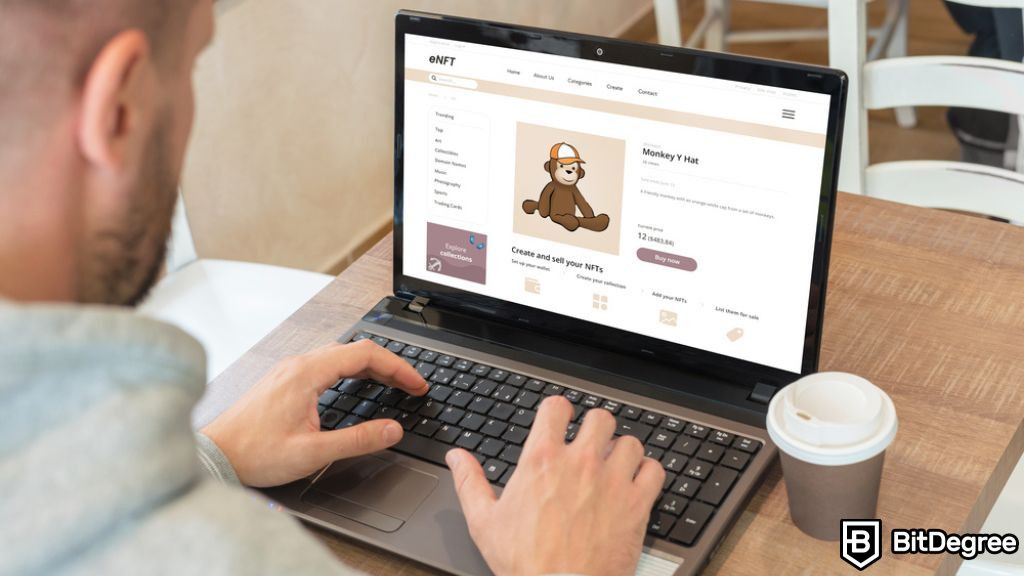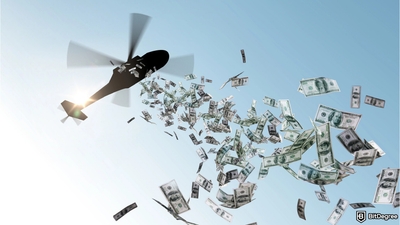Key Takeaways
- Building a strong community around the artwork is important for your NFT digital marketing strategy to connect with potential collectors and showcase your work.
- While organic social media can be powerful, consider integrating targeted strategies like influencer collaborations or paid NFT advertising to maximize your reach.
- Continuously analyze your NFT marketing performance across different channels, trends, and competitors to stay relevant. Then, adjust your strategy accordingly for optimal impact.
Free Airdrop Season 7 is LIVE! Answer fun questions or do simple tasks to earn rewards from the $30K BitDegree prize pool. Participate Now ! 🔥
Non-fungible tokens (NFTs) are changing the game for artists, creators, and collectors. They're opening up a whole new world of buying, selling, and trading things that exist online – from artwork to music and game items. But with so much digital art out there, just creating an artwork isn't enough – you need a smart NFT marketing strategy to truly succeed.
Effective marketing for NFTs will not only get your projects seen by the right people but also build a strong brand, connect with your audience, and ultimately sell your work.
Just note that to sell NFTs, you'll also need to have a crypto wallet. It's like your gateway to the NFT world, allowing you to interact with the platforms and, most importantly, receive cryptocurrency payments for your creations. Security-conscious creators can choose a hardware wallet like Ledger Nano X. It stores cryptos offline, making it much more resistant to hacking than online wallets.

Did you know?
Subscribe - We publish new crypto explainer videos every week!
Crypto Research Fundamentals: How to DYOR (Animated Explainer)


Table of Contents
- 1. What is NFT Marketing?
- 2. 6 Successful NFT Marketing Approaches
- 2.1. Build Strong Branding Strategies
- 2.2. Create Compelling Content on Your Website and Social Media
- 2.3. Engage With NFT Communities and Influencers
- 2.4. Offer Exclusive Perks
- 2.5. List Your NFTs on Leading NFT Marketplaces
- 2.6. Develop an Effective NFT Advertising Campaign
- 3. Measuring NFT Marketing Performance
- 4. Conclusions
What is NFT Marketing?
Put shortly, NFTs are unique digital assets (e.g., music, video game items, and social media posts) recorded on a blockchain, but what is NFT marketing? It refers to the strategies used to promote and sell these non-fungible tokens and aims to create awareness, generate interest, and ultimately drive sales of your assets.
Latest Deal Active Right Now:Head to BitDegree Missions, gather as many Bits as possible & claim your stake of the $30,000 Prize Pool! Don't waste your time & start collecting Bits by completing Missions and referring friends.
NFT marketing can involve:
- Selling the NFTs. NFTs can be sold directly through a website or on NFT marketplaces.
- Promoting the NFTs. This step uses various marketing channels to build awareness and interest in the NFTs among a target audience. It can include social media marketing, creator collaborations, and community building.
NFT marketing presents numerous opportunities for collaborations, sales, and visibility. However, it comes with its challenges. One of them is high competition. The NFT market has become highly competitive with a flood of new projects, making it difficult to stand out. In fact, there are over 1.7 million collections and over 1 billion NFTs have been listed.
Moreover, the NFT space has been filled with scams and fraudulent projects, leading to a general lack of trust among potential buyers.
Therefore, NFT artists need to use a mix of marketing channels and strategies to reach their target audience effectively and adapt to market changes.
6 Successful NFT Marketing Approaches
Now you know the answer to "What is NFT marketing?". However, putting that knowledge into action is key. To ensure your project finds its audience and thrives, you need to come up with a strategic marketing plan for your NFTs.
Here, let's explore 6 effective methods that will help you build a strong community, increase desirability, and achieve your sales goals.
Build Strong Branding Strategies
Creating a strong brand for NFTs is essential for building a recognizable and trusted presence in the market. It helps make your NFTs more appealing and memorable than others.
Consistently communicating your story, values, and the quality of your work can also build a loyal community around your NFTs, encouraging repeat purchases and word-of-mouth promotion.
The first step is to make a clear brand identity, involving:
- Creating a memorable name
- Designing a catchy logo
- Developing a consistent visual style
A unique name sets you apart from other artists and helps the audience identify and remember your work. My best practice is to choose a name that reflects your artistic style and themes. Also, opt for a name that’s easy to pronounce, spell, and remember. Complex names may confuse potential buyers.
Once you've brainstormed potential names, test them with friends, colleagues, or members of your target audience to see their reactions. Refine the options based on feedback until you find a name that feels right.
Before finalizing your option, ensure the corresponding domain name and social media handles are available. Consistent branding across all platforms is key to building a cohesive and recognizable online presence.
After coming up with a name, design a logo that visually represents your brand and complements the identity you want to convey.
To speed up the name and logo creation process, consider using a name and logo generator like Namelix. The tool can provide inspiration and suggestions based on your preferences and criteria, like name style and randomness, and lets you check the domain name availability directly.
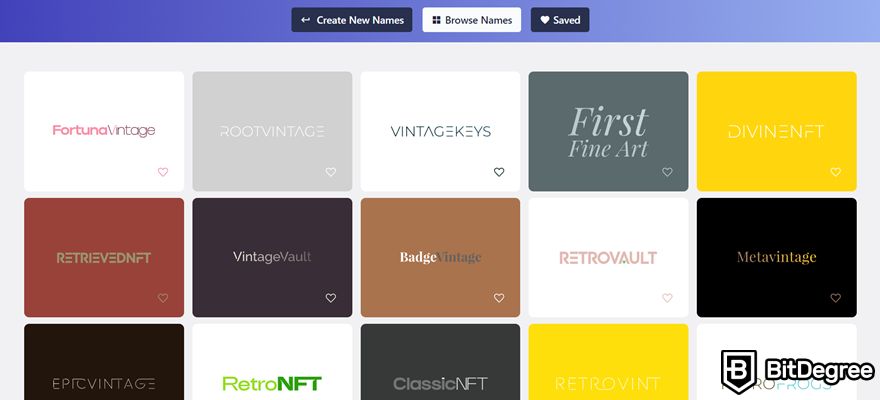
Then, create a consistent visual style, involving color schemes, typography, and design elements. Consistent visual branding reinforces your identity and makes your NFTs instantly recognizable across platforms, whether they're viewed on social media, marketplaces, or your own website.
Canva is a graphic design tool that can help create a visual style for your NFT brand. It offers various templates, design elements, and customization options. The platform is also user-friendly and suitable for both beginners and experienced designers.
You now have a unique name, logo, and visual style. The next step in a successful NFT marketing technique is to make a compelling brand story.
Share the story behind your NFTs, including the inspiration, creation process, and your journey as a creator. This personal touch helps build an emotional connection with your audience.
Clearly express your mission and the values that drive your NFT project. Whether it’s supporting self-expression or promoting sustainability, make sure your audience understands what you stand for.

Refik Anadol is one of the best NFT artists to look up to when building branding strategies. He’s a Turkish media artist known for his mesmerizing audio-visual works that often explore sustainability and nature in many of his projects.
His online presence is characterized by a sleek style to highlight his captivating artwork. Anadol’s website serves as a digital gallery, showcasing his installations and digital sculptures.
In addition to his website, Anadol maintains an active presence on social media, leveraging it for effective NFT marketing. He shares behind-the-scenes glimpses of his creative process, updates on upcoming projects, and insights into the themes and inspirations behind his artwork.
Create Compelling Content on Your Website and Social Media
Consistent content creation helps build your reputation as an NFT artist by sharing behind-the-scenes posts of your creative process, telling the story behind each artwork, and engaging with the audience.
This NFT digital marketing strategy allows you to build a network of supporters, like-minded individuals, and collaborators, which can turn into customers.
To start, choose the most suitable platform based on your target audience, content preferences, and marketing goals. See where your audience is most active and engaged to maximize your reach and impact as an NFT artist.
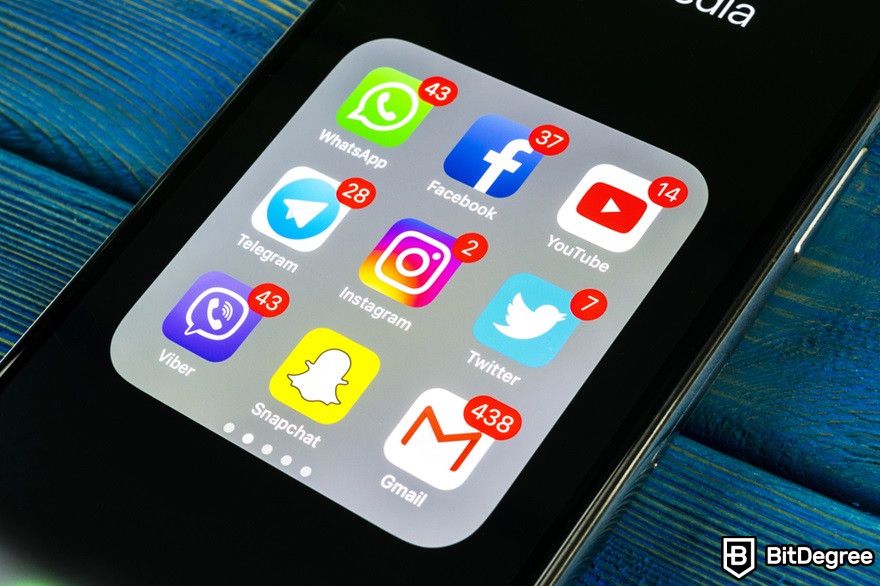
In my opinion, Instagram is an excellent choice to showcase artwork through high-quality images and short videos. NFT artists can create a visually appealing feed to display their projects, share behind-the-scenes or educational content, and interact with their audience through likes, comments, and direct messages.
If you aim to find a community-focused platform, opt for Discord. Here, you can create private or public servers to engage with the audience, host live events, share exclusive content, and build a sense of community around the artwork.
Don’t worry, you can always use several different platforms to promote NFTs and engage with your audience. However, my recommendation is to limit it to a few to help focus your time and resources more effectively.
While social media platforms are great for reaching a wide audience and building engagement, a website is essential for establishing a centralized hub for your brand and artwork. That’s why, consider making a professional website to showcase your NFTs, share stories, and provide a seamless browsing and purchasing experience for collectors.

After signing up for selected social media and building your website, create a content calendar to regularly post updates, teasers, behind-the-scenes, and user-generated content. Scheduling ahead helps maintain a steady flow of content that keeps your audience informed and excited about your NFT releases and artistic journey.
Then, start creating the content! Remember to tailor it to each platform's strengths and audience preferences. For example, use Instagram to showcase visually stunning images and videos of your NFTs, while filling your website with in-depth articles and portfolio showcases.
Throughout the content creation journey, don’t forget to actively engage with your followers by responding to comments, participating in conversations, and hosting Q&A sessions.
Engage With NFT Communities and Influencers
Communities are an important aspect of marketing for NFT. They provide valuable insights into market trends, collector preferences, and collaboration opportunities. Actively participating in discussions and observing interactions will help you stay informed and adapt your marketing strategies accordingly.
Join online forums, Discord servers, and social media groups dedicated to NFTs. A key takeaway is to focus on providing value to the communities by:
- Sharing helpful resources
- Offering support and encouragement to fellow artists
- Contributing positively to the discussions
Genuine engagement and generosity go a long way in building rapport and earning the respect of your peers.
Additionally, take advantage of offline opportunities to connect with NFT communities and influencers. Attend industry conferences, art exhibitions, and meetups where you can network with like-minded individuals, showcase your work, and develop meaningful connections face-to-face.
If you have more budget, consider collaborating with influencers for your NFT marketing strategy. Partnering with them allows you to tap into their existing audience and reach new potential collectors for your NFTs.
However, don’t just choose any influencer. To build a strong NFT digital marketing approach, find relevant people that share the same values as your brand and audience[1]. Partnering with irrelevant influencers can backfire, confusing your audience and potentially damaging your brand reputation.
Here are some criteria to consider when selecting influencers:
- Relevance and track record. Look for influencers who are genuinely interested in NFTs and have a track record of engaging with the NFT community. This alignment ensures that their endorsement will be authentic and resonate with their followers.
- Engagement and audience demographics. Check the influencer's engagement metrics, including likes, comments, and shares on their posts. High engagement generally indicates an active audience. Moreover, analyze the demographics of the influencer's followers, such as age and interests, to ensure they match your target audience.
- Content quality. Evaluate the quality of the influencer's content, including their visuals, captions, and storytelling. Top-tier content will reflect well on your brand.
- Niche influence. Sometimes, influencers with a smaller but highly dedicated and niche following can be more effective than those with a broader audience. Their recommendations can carry more weight within their specific community.
After choosing the right influencer, decide on the types of collaborations you want to pursue. One of the most common options is sponsored posts, where the influencer shares posts on their social platforms featuring your NFTs.
You can also ask them to host giveaways where participants have a chance to win one of your NFTs. Alternatively, co-host live streams or Q&A sessions with them about general NFT topics or your project specifically.
Offer Exclusive Perks
Exclusive perks are a game-changer in NFT marketing. They elevate your artwork by offering additional benefits, making them more attractive to collectors and strengthening your community through a sense of appreciation.
Types of exclusive perks you can offer include:
- Limited edition content. Design limited edition or one-of-a-kind NFTs that offer something unique. This strategy encourages people to buy more[2].
- Early bird access. Offer buyers of your current NFTs exclusive access to future drops. This can create a sense of anticipation, encouraging collectors to purchase your NFTs to get these benefits.
- Membership benefits. Create a membership club for your NFT holders that includes perks such as access to private events, exclusive content, or special discounts on future NFTs. Membership benefits can build a strong sense of community and belonging.

- Real-world benefits. Link your NFTs to real-world perks such as physical merchandise, VIP tickets to events, or personal interactions with you as the artist. This can bridge the digital and physical worlds and let you connect with your audience in-person.
- Collaborative opportunities. Give NFT holders a voice in your creative process. They can contribute ideas, participate in polls, or even co-create new artwork. This builds a deeper connection and makes them feel like valued partners.
My advice to maximize this NFT marketing approach is to clearly define what exclusive perks you will offer. Make sure these perks are valuable and desirable to your target audience.
For example, if many of your followers are gamers, you can integrate gaming and metaverse to grant access to certain features or in-game items within a specific play-to-earn game or metaverse platform.
If the audience is more traditional art collectors, you can provide the offline version of your digital art. Fidenza by Tyler Hobbs, for instance, lets the holder claim a high-resolution printable file of the artwork.
After deciding the types of exclusive benefits, communicate them effectively to potential buyers in your marketing materials, social media posts, and website content.

Did you know?
Subscribe - We publish new crypto explainer videos every week!
Candlesticks, Trendlines & Patterns Easily Explained (Animated Examples)


List Your NFTs on Leading NFT Marketplaces
Top NFT marketplaces are like bustling art fairs for the digital age. Listing your NFTs there connects you with a vast and varied pool of potential collectors from all over the world.
Some recommended NFT marketplace for you to try selling your artwork are:
OpenSea
OpenSea is one of the largest and most popular NFT marketplaces, known for its wide variety of NFTs and user-friendly interface. This platform may be a good starting point due to its high visibility. While offering a wide range of options, OpenSea transactions typically involve gas fees on the blockchain, which can add cost.
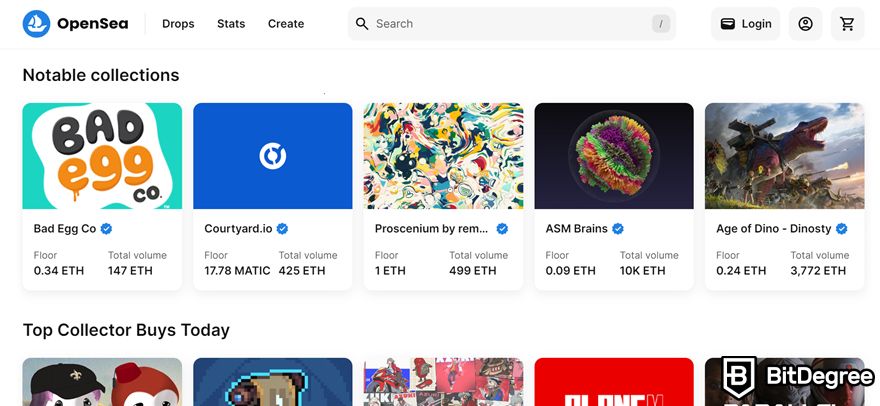
Binance NFT
Binance NFT offers extensive reach and visibility due to its huge user base, but it can be highly competitive.
In this platform, creators choose a royalty percentage that they'll get for every secondary sale of their NFT. Also, Binance itself charges a flat 1% platform service fee on the sale price for third-party platform NFTs listed on their marketplace.
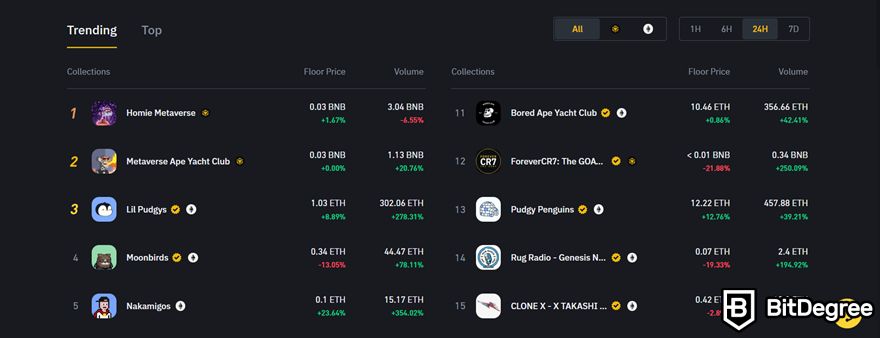
Kraken NFT
Kraken NFT supports NFTs on multiple blockchains, offering buyers and sellers more options. Another advantage is that this marketplace eliminates gas fees, which can be a significant cost on other platforms.
The Kraken marketplace also allows users to buy NFTs with fiat currencies (traditional money like USD or EUR) using credit cards or debit cards, removing a barrier to entry for those new to the crypto world.
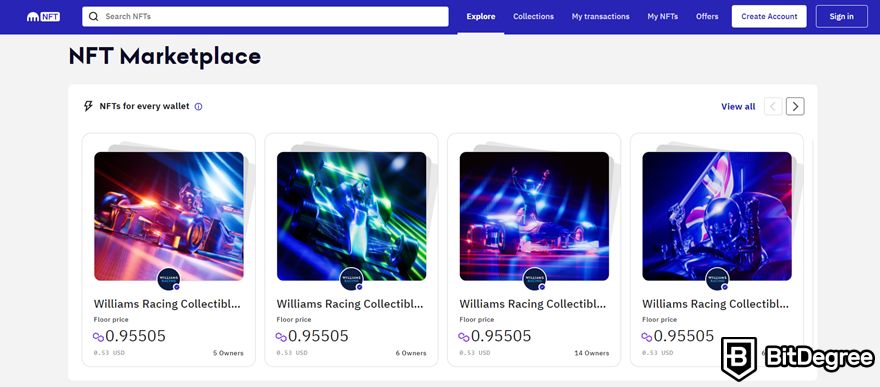
Rarible
This is a decentralized marketplace with minimal restrictions and a focus on curated art collections. It lets artists mint for free through lazy minting and offers more flexibility in setting minting parameters.
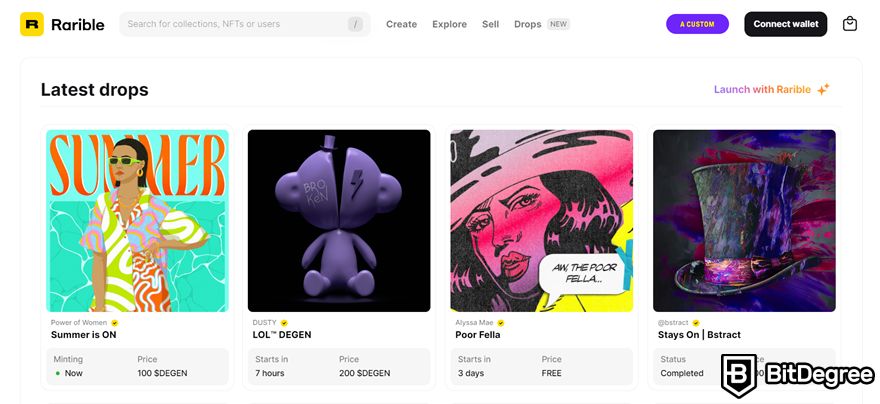
Foundation
This is an invite-only NFT marketplace known for its curated selection of digital artwork. The artist onboarding can be highly selective, but it offers an opportunity to build a strong reputation and command premium prices.

Choosing the right marketplace depends on several factors, such as:
- Your artistic style and target audience
- The fees associated with minting and selling NFTs
- The level of community support offered by the platform
For example, if you prioritize prices and user-friendliness in your criteria, consider choosing the Kraken NFT marketplace where there are no gas fees for buying and selling NFTs on the platform. This makes it a cost-effective option for both collectors and artists.
Meanwhile, if you value a wider selection of up-and-coming artists and the potential for higher returns, a platform like OpenSea, despite its gas fees, might be a better fit.

- Secure and reliable
- Accepts fiat currencies
- Lots of trading options
- Reputable exchange
- Accepts fiat currencies
- Offers various trading options

- Fiat currencies - accepted
- Simple to use
- Accepts only the most trustworthy cryptocurrencies
- A leading cryptocurrency exchange platform
- Best for beginner investors
- Accepts fiat currencies

- Fully reserved and transparent
- Multiple tradable asset classes
- Over 300 supported cryptos
- Over 300 cryptocurrencies
- Secure & transparent
- Fully reserved
Develop an Effective NFT Advertising Campaign
Ads can boost the visibility of your NFTs by reaching a broader audience, including those who may not actively search for NFTs but are interested in digital art and collectibles.
If you want to target a specific audience, ad platforms also allow you to focus on certain demographics, interests, and behaviors. That way, you can ensure that the ads reach the most relevant potential buyers.
To optimize your NFT advertising strategy, start by setting clear objectives. This can include increasing brand awareness, driving traffic, or generating leads. Different goals typically require specific targeting methods and metrics.

For example, if you aim to boost visibility, you may focus on reaching a broad audience to maximize exposure with metrics like impressions and reach.
Meanwhile, NFT artists who want to increase sales can use retargeting ads to reach users who have previously shown interest in their artwork but have not yet made a purchase. The metrics for this NFT advertising technique include conversion rates and return on ad spend (ROAS).
Now, it's also important to define your target audience based on factors such as age, gender, location, interests, and online behavior to help create ads that resonate with them.
Select the most effective ad platform for reaching your target audience. Popular options for NFT advertising include:
- Social media ads. Platforms like Instagram, X, and Facebook offer powerful targeting options and large audiences.
- Google ads. Use Google’s search and display networks to reach users actively searching for NFTs or related content.
- Crypto and NFT-specific platforms. Advertise on online communities like Reddit or NFT-specific newsletters and blogs.
Once you pick a platform, design eye-catching visuals and write engaging copy that highlights the unique aspects of your NFTs. Use high-quality images or videos to showcase your artwork and include a clear call-to-action (CTA) encouraging users to learn more or make a purchase.
Pay attention to the ad size recommended by the platform you choose. Ensuring your visuals fit the platform's specifications is important, as they impact your ad performance.
Consider retargeting ads to reach users who have previously interacted with your website or social media profiles. Retargeting helps keep your NFTs top-of-mind for potential buyers who might need multiple touchpoints before making a purchase.
Be patient! Success may not come on the first try. Continuously monitor the performance of your ad campaign using specific metrics based on your objective.
Measuring NFT Marketing Performance
Empowered with the answer to "What is NFT marketing?" and six actionable strategies, it's time to explore the essential metrics that help measure your success.
Measuring the performance of your NFT marketing and advertising efforts helps ensure that your strategies are effective, resources are used efficiently, and goals are met. It lets you optimize strategies by focusing on the most effective methods and refining or discarding underperforming approaches.
For instance, if you notice that behind-the-scenes content gets higher engagement than other types of posts, you can adjust the content strategy to include more of this content. If data shows a steady increase in interest in augmented reality (AR) NFTs, you may want to consider creating AR experiences as part of your future NFT offerings.
Several key metrics to track include:
- Impressions. These reflect how often your ad or content is seen.
- Reach. It refers to the number of unique users who see your ad or content. Reach indicates the breadth of your audience.
- Total engagements. These show the total number of interactions, such as likes, comments, and shares, providing insight into overall audience interest and activity.
- Engagement rate. It’s the percentage of people who interact with your content after seeing it, dividing the total number of engagements per post by your reach per post.
- Website traffic. It displays the total number of pages viewed, identifying popular content and areas for improvement.
- Return on ad spend. It refers to the revenue generated from your ad campaign divided by the cost of the ads. A higher ROAS translates into a more profitable campaign.
Social platforms generally have a built-in dashboard to help analyze your NFT marketing performance. If you create your site using website builders like Wix and Squarespace, you’ll also get insights such as traffic and audience demographics directly on the platform. Meanwhile, WordPress users can use Google Analytics for detailed analytics of their website.
Besides those metrics above, keeping an eye on trends is crucial to planning NFT digital marketing efforts. It helps you stay relevant and capitalize on emerging opportunities.
For example, creating NFTs related to major holidays, sporting events, or cultural phenomena can boost engagement and sales during specific times of the year.

The "Disaster Girl" meme, featuring a young girl smirking at the camera with a house fire in the background, was minted and sold as an NFT for $500,000 by the original photographer and the girl in the photo. This NFT sale capitalized on the widespread recognition and virality of the meme.
My recommendation is also to check your competitors. Analyzing their strategies can provide valuable insights into what works and what doesn’t in the NFT space. Pay attention to competitors’ most successful project launches and NFT marketing campaigns. Check elements contributing to their success, such as the type of content they produce and the platforms they use.
You can note the style, tone, frequency, and topics that seem to engage their audience the most. Also, see how they respond to comments, handle customer service issues, and engage in discussions. To filter potential partners effectively, check their partnerships and collaborations as well. See whether you can consider pursuing a similar collaboration to expand reach and credibility.
Then, understand competitors’ pricing models. This helps you position your offerings competitively while ensuring you’re maximizing the potential profits. When studying competitors, remember that originality is key. Draw inspiration from their strategies, but ensure your NFTs have a distinct voice and identity to truly resonate with collectors.
I recommend you monitor the performance metrics weekly to ensure timely adjustments and stay on top of emerging trends or issues. Then, conduct a more comprehensive monthly analysis to understand broader trends and measure the overall success of your strategies over time.
Conclusions
NFTs aren't dead; they're evolving. However, getting them noticed takes a well-crafted answer to “What is NFT marketing all about?”.
Now, you understand that your creative process doesn't end after you finish making the artwork. I want to emphasize that an effective strategy is necessary to showcase your work, build a strong brand identity, and connect with the right collectors and fans in the NFT space.
Use social media, sell your work on leading marketplaces, and consider paid ads to make sure people see your NFTs. Monitor what's working and adjust your plan as you go. With continuous and strategic marketing for NFT, you can be a star in this digital art world!
Pro tip: Don't forget your crypto wallet! It's like your secure vault for the NFT world. There are many options, but for creators who prioritize security, a hardware wallet like Ledger Nano X is a great choice. This way, you can safely store any cryptocurrency you earn from your sales.
The content published on this website is not aimed to give any kind of financial, investment, trading, or any other form of advice. BitDegree.org does not endorse or suggest you to buy, sell or hold any kind of cryptocurrency. Before making financial investment decisions, do consult your financial advisor.
Scientific References
1. D. Venciute, I. Mackeviciene, M. Kuslys, et al.: ‘The Role of Influencer–Follower Congruence in the Relationship Between Influencer Marketing and Purchase Behaviour’;
2. W. Kim, B. Kim: ‘Consumption Motivation of Limited Edition Product in Reselling Open Market’.

